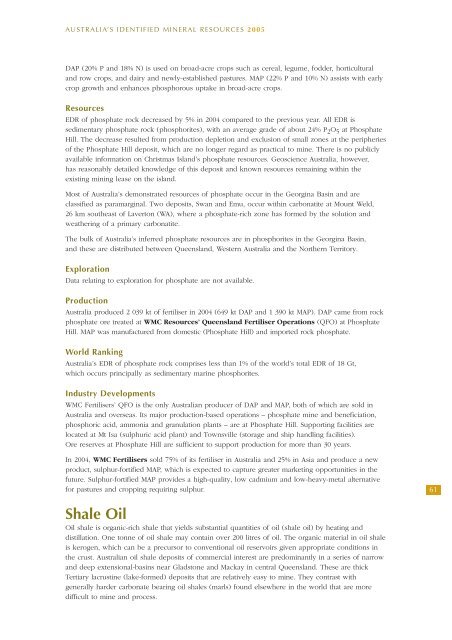australia's identified mineral resources 2005 - Geoscience Australia
australia's identified mineral resources 2005 - Geoscience Australia
australia's identified mineral resources 2005 - Geoscience Australia
Create successful ePaper yourself
Turn your PDF publications into a flip-book with our unique Google optimized e-Paper software.
AUSTRALIA’S IDENTIFIED MINERAL RESOURCES <strong>2005</strong><br />
DAP (20% P and 18% N) is used on broad-acre crops such as cereal, legume, fodder, horticultural<br />
and row crops, and dairy and newly-established pastures. MAP (22% P and 10% N) assists with early<br />
crop growth and enhances phosphorous uptake in broad-acre crops.<br />
Resources<br />
EDR of phosphate rock decreased by 5% in 2004 compared to the previous year. All EDR is<br />
sedimentary phosphate rock (phosphorites), with an average grade of about 24% P 2 O 5 at Phosphate<br />
Hill. The decrease resulted from production depletion and exclusion of small zones at the peripheries<br />
of the Phosphate Hill deposit, which are no longer regard as practical to mine. There is no publicly<br />
available information on Christmas Island’s phosphate <strong>resources</strong>. <strong>Geoscience</strong> <strong>Australia</strong>, however,<br />
has reasonably detailed knowledge of this deposit and known <strong>resources</strong> remaining within the<br />
existing mining lease on the island.<br />
Most of <strong>Australia</strong>’s demonstrated <strong>resources</strong> of phosphate occur in the Georgina Basin and are<br />
classified as paramarginal. Two deposits, Swan and Emu, occur within carbonatite at Mount Weld,<br />
26 km southeast of Laverton (WA), where a phosphate-rich zone has formed by the solution and<br />
weathering of a primary carbonatite.<br />
The bulk of <strong>Australia</strong>’s inferred phosphate <strong>resources</strong> are in phosphorites in the Georgina Basin,<br />
and these are distributed between Queensland, Western <strong>Australia</strong> and the Northern Territory.<br />
Exploration<br />
Data relating to exploration for phosphate are not available.<br />
Production<br />
<strong>Australia</strong> produced 2 039 kt of fertiliser in 2004 (649 kt DAP and 1 390 kt MAP). DAP came from rock<br />
phosphate ore treated at WMC Resources’ Queensland Fertiliser Operations (QFO) at Phosphate<br />
Hill. MAP was manufactured from domestic (Phosphate Hill) and imported rock phosphate.<br />
World Ranking<br />
<strong>Australia</strong>’s EDR of phosphate rock comprises less than 1% of the world’s total EDR of 18 Gt,<br />
which occurs principally as sedimentary marine phosphorites.<br />
Industry Developments<br />
WMC Fertilisers’ QFO is the only <strong>Australia</strong>n producer of DAP and MAP, both of which are sold in<br />
<strong>Australia</strong> and overseas. Its major production-based operations – phosphate mine and beneficiation,<br />
phosphoric acid, ammonia and granulation plants – are at Phosphate Hill. Supporting facilities are<br />
located at Mt Isa (sulphuric acid plant) and Townsville (storage and ship handling facilities).<br />
Ore reserves at Phosphate Hill are sufficient to support production for more than 30 years.<br />
In 2004, WMC Fertilisers sold 75% of its fertiliser in <strong>Australia</strong> and 25% in Asia and produce a new<br />
product, sulphur-fortified MAP, which is expected to capture greater marketing opportunities in the<br />
future. Sulphur-fortified MAP provides a high-quality, low cadmium and low-heavy-metal alternative<br />
for pastures and cropping requiring sulphur.<br />
61<br />
Shale Oil<br />
Oil shale is organic-rich shale that yields substantial quantities of oil (shale oil) by heating and<br />
distillation. One tonne of oil shale may contain over 200 litres of oil. The organic material in oil shale<br />
is kerogen, which can be a precursor to conventional oil reservoirs given appropriate conditions in<br />
the crust. <strong>Australia</strong>n oil shale deposits of commercial interest are predominantly in a series of narrow<br />
and deep extensional-basins near Gladstone and Mackay in central Queensland. These are thick<br />
Tertiary lacrustine (lake-formed) deposits that are relatively easy to mine. They contrast with<br />
generally harder carbonate bearing oil shales (marls) found elsewhere in the world that are more<br />
difficult to mine and process.

















